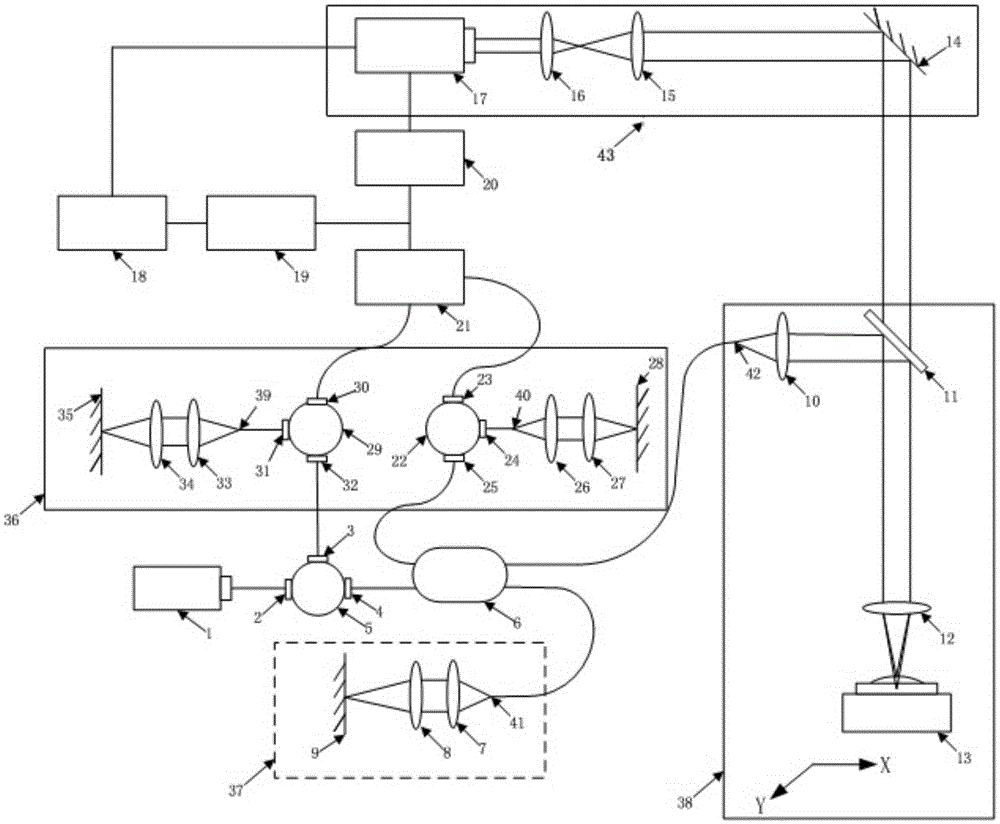Non-contact photoacoustic detecting method and device based on optical interferometry
An optical interference and non-contact technology, which is applied in the generation of ultrasonic/sonic/infrasonic waves, and the use of sound waves/ultrasonic/infrasonic waves to analyze fluids, etc. It can solve the problems affecting imaging stability and repeatability, PAI application range limitations, and imaging cannot be performed, etc. problem, to achieve the effect of improving system sensitivity, high sensitivity, improving stability and repeatability
- Summary
- Abstract
- Description
- Claims
- Application Information
AI Technical Summary
Problems solved by technology
Method used
Image
Examples
Embodiment 1
[0032] A non-contact photoacoustic detection method based on optical interferometry, comprising the following steps:
[0033] S1. Photoacoustic excitation: a liquid layer is added to the surface of the sample, and the sample is irradiated by the photoacoustic excitation system. The sample absorbs laser energy and generates pressure waves, which are transmitted to the liquid, causing the liquid surface to vibrate;
[0034] S2. Optical coherence detection: the light emitted by the coherent light source is divided into two paths, one path is used as the probe light to enter the sample system and then focused on the sample surface, and the other path is used as the reference light to enter the reference system. The two paths of light are the probe light reflected by the sample surface And the reference light reflected by the reference system returns along the original optical path, and is divided into two paths again to send out;
[0035] S3. Balance adjustment: In step S2, the li...
Embodiment 2
[0038] A non-contact photoacoustic detection method based on optical interferometry, comprising the following steps:
[0039] S1. Photoacoustic excitation: There is a liquid layer on the surface of the sample. The photoacoustic excitation light source in the photoacoustic excitation system emits laser light with a pulse width less than 10 ns to irradiate the sample. The sample absorbs the laser energy and generates pressure waves, which are transmitted to the liquid, making The surface of the liquid layer on the surface of the sample vibrates;
[0040] S2. Optical coherent detection: the light emitted by a coherent light source with a coherent length of 1mm enters the coupler through a circulator and is divided into two paths. One path is used as the probe light and enters the sample system and then focuses on the surface of the liquid layer on the sample surface. The other path is used as The reference light enters the reference system, and the two-way light, namely the probe...
Embodiment 3
[0044] A non-contact photoacoustic detection method based on optical interferometry, comprising the following steps:
[0045] S1. Photoacoustic excitation: There is a liquid layer on the surface of the sample. The photoacoustic excitation light source in the photoacoustic excitation system emits laser light with a pulse width less than 10 ns to irradiate the sample. The sample absorbs the laser energy and generates pressure waves, which are transmitted to the liquid, making The surface of the liquid layer on the surface of the sample vibrates;
[0046] S2. Optical coherent detection: the light emitted by a coherent light source with a coherent length of 1m is divided into two paths after entering the coupler through a circulator. The reference light enters the reference system, and the two-way light, namely the probe light reflected by the liquid layer on the sample surface and the reference light reflected by the reference system, returns along the original light path, enters...
PUM
| Property | Measurement | Unit |
|---|---|---|
| Coherence length | aaaaa | aaaaa |
Abstract
Description
Claims
Application Information
 Login to View More
Login to View More - R&D
- Intellectual Property
- Life Sciences
- Materials
- Tech Scout
- Unparalleled Data Quality
- Higher Quality Content
- 60% Fewer Hallucinations
Browse by: Latest US Patents, China's latest patents, Technical Efficacy Thesaurus, Application Domain, Technology Topic, Popular Technical Reports.
© 2025 PatSnap. All rights reserved.Legal|Privacy policy|Modern Slavery Act Transparency Statement|Sitemap|About US| Contact US: help@patsnap.com

